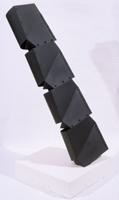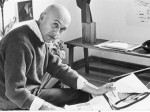
Edgar Negret
Colombian, 1920-2012
Torre No. 3 (Tower No. 3), 1969
painted aluminum
52 x 14 x 8 in.
SBMA, Gift of Robert B. and Mercedes H. Eichholz
1995.50.3

Negret at work in his studio
COMMENTS
Edgar Negret was born in Popayán in 1920, the same year as both Obregón and Grau, with whose careers his own provides a fascinating contrast. By age eighteen he was attending the School of Fine Arts in Cali, in the southwestern part of the country. In 1948, while home in Popayán, he met the Spanish sculptor Jorge de Oteiza, who decisively influenced his early work.
In 1950, following a stay in Manhattan, Negret went off to Europe, residing for short periods first in Barcelona and then in Mallorca and Paris. While living in New York, Negret came to know such United States artists as Louise Nevelson, Jack Youngerman and Ellsworth Kelly. By 1955 his prestige was on the ascendant. Among the exhibitions in which he participated was "New Acquisitions," at New York's Museum of Modern Art. An excellent example of his work of this period is provided by the series of "Magic Apparatuses," presented at the 1957 São Paulo Biennial and in Bogotá the following year. [In the present exhibit, Map belongs to this series, while Space Navigator and Metallic Tower are later works.] Negret received worldwide public recognition in 1968, when his work was awarded the David E. Bright international prize for sculpture at the Thirty-fourth Venice Biennial.
Negret's work abounds in allusions to post-war technology. Their precise, blade-like edges are tempered by intelligent handling, which causes us to question the relevance of our present concerns and our anxieties with regard to the future. As objects, his sculptures lead us likewise to question the roles that other objects play, both in our own lives and in our communities, like it or not. This attitude of questioning has led both Negret and Ramírez Villamizar although they have taken opposite directions to investigate ancient artifacts. From them the two sculptors have extracted elements of poetry and mystery that impart a timeless quality to their compositions.
Negret's sculptures are like magic vessels within which a genie lies hidden. By touching them with the imagination, one can impart other qualities to their mechanical coldness and functionality. These works remind us that we cannot escape the impersonality of mass production and the homogenization of daily life and must find some means of harmonious adaptation.
http://www.iadb.org/exr/cultural/catalogues/colombia/ennegret.htm
SBMA CURATORIAL LABELS
Negret spent most of his life in Colombia but lived in New York in 1948–50 and 1953–63. He bolted together industrial metal parts to make units that he then repeated. As with Tower No. 3, these units are hollow, so they join together like segments of tube. This sculpture’s precarious yet stable tilt resembles the works in this exhibition by Tsutakawa and Noguchi. All of them have a dynamic balance that reminds the viewer that gravity is part of what the sculptor has to overcome.
- Going Global, 2022
In January 1949, following the death of his mother, Edgar Negret settled in New York, a city he described as “magic”, where he met Ellsworth Kelly and Louise Nevelson, and was moved by the work of Alexander Calder. Although periodically traveling in the Southwestern United States and Europe, he remained in New York for almost fifteen years. He was particularly impressed with the city’s sense of modernity—the automated nature of subways and vending machines, and the way in which skyscrapers soared above, seemingly without limits.
After his return to Colombia in 1963, Negret began producing works that reflected these interests, reducing his colors to just one of three: black, white, or red. The paint he began using was commonly used to coat industrial products, and its matte finish negated any seductive potential of a shiny surface that would pull attention away from the form itself. His works from the 1960s ranged thematically from the sacred (temples, stairs) to urban construction (towers, bridges, edifices), to outer space (navigators, dockings)—all sharing similar formal qualities. Unlike the Minimalists with whom he is often associated, Negret did not use prefabricated materials, but rather hand cut strips of aluminum, carefully bending and bolting them into place. As such, his forms hover between the industrial and organic.
- SBMA title card, 2013
Edgar Negret’s sculptural use of mass-produced industrial materials links him directly to Minimalism. While residing in New York and dialoguing with Minimalists such as Ellsworth Kelly, Negret developed a signature style of sculpture based on simple, modular shapes that could be joined to form large-scale vertical or horizontal structures.
Made of painted aluminum units that are bolted together, Tower No. 3, for example, exhibits a modernist use of materials, space, and volume that exemplifies why Negret became a leading proponent for reductive, geometric abstraction in Latin America. While reflective of the modern city and new technology, this work also is tied to Negret’s appreciation of pre-Columbian art and culture. Inspired by the pre-Columbian concept of animism, Negret attempts to invest this ascending spiral with a sense of soul or spirit.
- SBMA Wall Text, 2000
